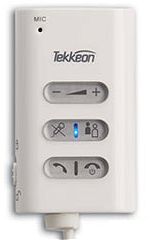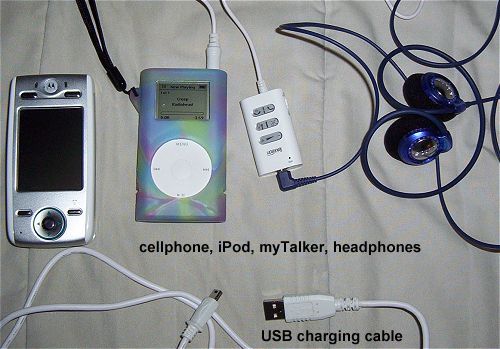Tekkeon, Inc. was very kind to send us a review unit of their new product, the "myTalker ET7000". myTalker is a very interesting Bluetooth gadget redefining the way you are listening to music and receiving phone calls at the same time. Read more for our impressions of the product.
 So far here at TuxTops we have reviewed a great number of stereo Bluetooth headphones and we found that when a model works well in one respect it would usually fail on another (e.g. good sound quality but with bad battery life, or the other way around). We have yet to find a stereo BT headset that does everything right (Plantronics' Pulsar is closer to perfection than others but it's handicaped by its poor sound quality). Maybe there is no "perfect" BT headset (at least not yet) as this is an early technology still.
So far here at TuxTops we have reviewed a great number of stereo Bluetooth headphones and we found that when a model works well in one respect it would usually fail on another (e.g. good sound quality but with bad battery life, or the other way around). We have yet to find a stereo BT headset that does everything right (Plantronics' Pulsar is closer to perfection than others but it's handicaped by its poor sound quality). Maybe there is no "perfect" BT headset (at least not yet) as this is an early technology still.
Maybe this is what the Tekkeon people thought too when they designed their myTalker ET7000 product. This iPod-white HSP/HFP-compatible Bluetooth headset takes a different approach into music-listening and cellphone support. This tiny device is connecting on your media player on the one end via a standard 3.5mm audio jack and it outputs the same jack on its other end. There, the user can connect any kind of headphones he/she desires, eliminating the usual problem of poor sound quality as found on most Bluetooth Stereo headphones. Sure, you still end up with wires, but at least you won't miss a call while listening to your mp3 player.
The device clips on your jacket the same way most handsfree devices do. The sound signal goes through the device and on to the headphones even when the myTalker is completely OFF. It's a pass-through device and quality does not degrade at all. When someone is calling your (paired) cellphone the music stops automatically and you can answer the call directly from the myTalker that's hanged on your shirt or jacket. There is an "answer" and a "hung up" button (rocker style buttons) and at the tip of the device there is a microphone that you can talk to (you can hear the other person talking via your normal headphones). When you are done with the call, you can press the "hung up" button to end the call. The music will automatically be resumed and passed through back to your headphones.
Pairing was a piece of cake, it is achieved by pressing-and-holding the hungup button for more than 4 seconds. Then the little light flashes blue and red, indicating that it's on pairing mode. By entering the 0000 number on your cellphone you can then pair the two devices together.
The myTalker supports a number of advanced calling features, like Call Reject, Call Transfer to/from phone, Call Waiting, Conference, Last number redial and Voice Dialing. Please note that for some of these features your phone must support too. It also takes a bit of manual-reading and experiementation to get all these actions work correctly. Nevertheless, the myTalker supports all important Call features one would expect from such a device. There is also a rocker button to change the headset's volume. The buttons have small light indicators to show the current mode, or if the device is on pairing mode, or if it's the device is charging etc. There is also a small sliding "Hold" button that makes sure that you don't press the buttons by mistake. This is a very nice design touch.
Cellphone call sound quality is good both ways of the line. Reception was very good as well (up to 7 meters).

Battery life is a mixed bag though. The device sports a bit less than 5 hours of talk time (which is not too bad), but the 120 hours of standby is a really low number because most modern phones can deliver more than 180 hours of standby. If you run out of battery and you happen to be on a trip you will also need a laptop with you to recharge the device, as it only comes with a USB charging cable and not an A/C adapter. This can be an issue for people who don't travel with laptops or only need a PDA with them.
The other two problems of the device have to do with usability. The clip-on should have been seperate and not part of the main device, because each time your phone rings, you have to literally grab and turn your shirt/jacket that the device is clipped on in order to find the correct button to answer or reject the call. This is just not elegant. Additionally, the rocker button design can be problematic because to an adult thumb there is a small difference between clicking the one action or the other. Two actions are part of the same button which carries action A or B just by pressing the same button left or right. A small mistake on this and bam! You just rejected a call instead of answering it!
In conclusion, this is a very interesting alternative design to the 30-35 Bluetooth stereo headset models that exist in the market right now. It works as advertised and it doesn't get in the way (despite the wiring). Its best feature is that it works with any headphone set, which is heaven for audiophiles who respect themselves & their ears and want to use good-quality headphones (Sony comes to mind). At the same time, you will never miss a call while listening to music, making this product the best of both worlds.
Pros:
* Unintrusive
* Good build quality
* Advanced calling features
* Works with all standard headphones
Cons:
* Usability problem with the clip-on and buttons
* Low standby times
* No A/C power adapter
Overall Rating: 8.5/10


 So far here at TuxTops we have reviewed a great number of stereo Bluetooth headphones and we found that when a model works well in one respect it would usually fail on another (e.g. good sound quality but with bad battery life, or the other way around). We have yet to find a stereo BT headset that does everything right (Plantronics' Pulsar is closer to perfection than others but it's handicaped by its poor sound quality). Maybe there is no "perfect" BT headset (at least not yet) as this is an early technology still.
So far here at TuxTops we have reviewed a great number of stereo Bluetooth headphones and we found that when a model works well in one respect it would usually fail on another (e.g. good sound quality but with bad battery life, or the other way around). We have yet to find a stereo BT headset that does everything right (Plantronics' Pulsar is closer to perfection than others but it's handicaped by its poor sound quality). Maybe there is no "perfect" BT headset (at least not yet) as this is an early technology still.